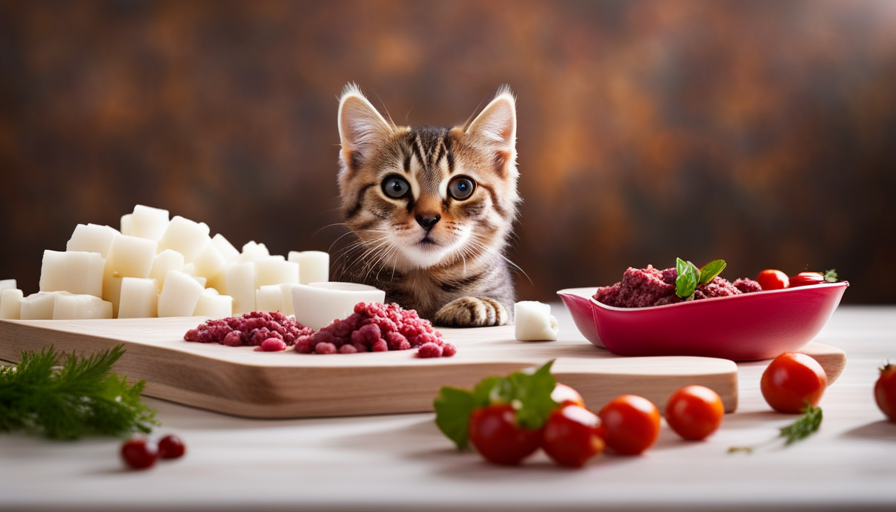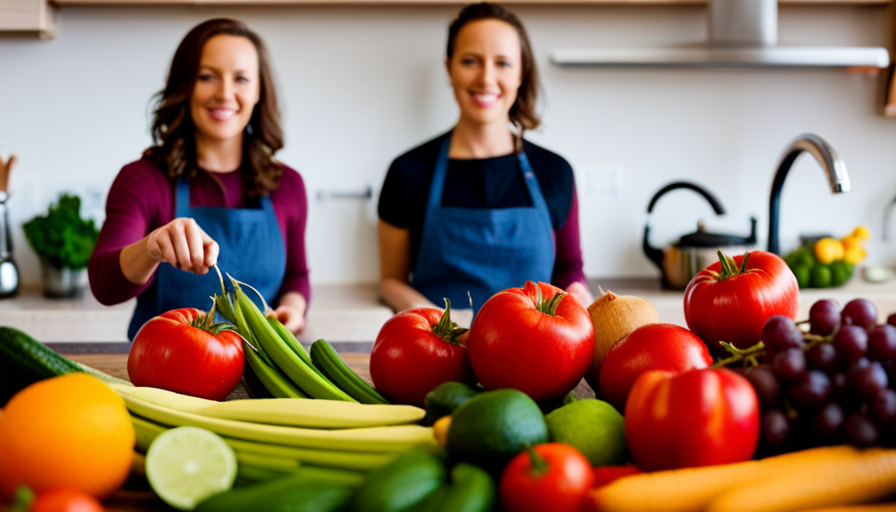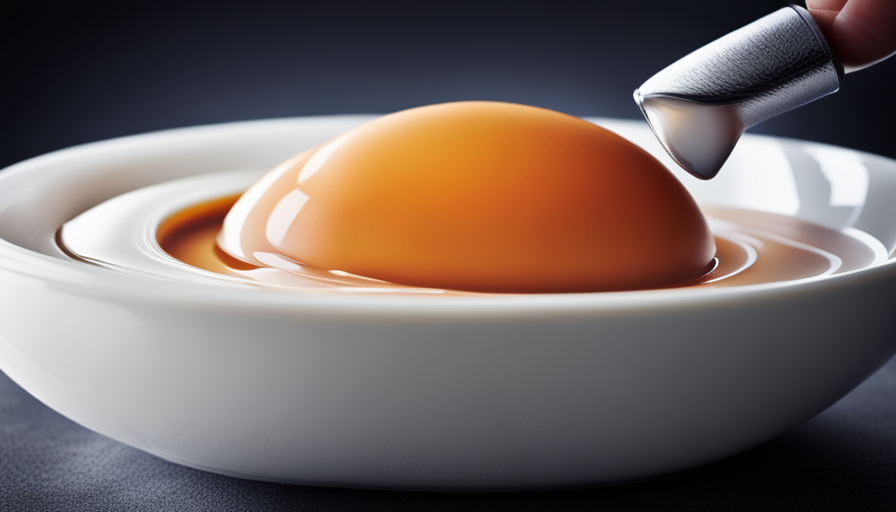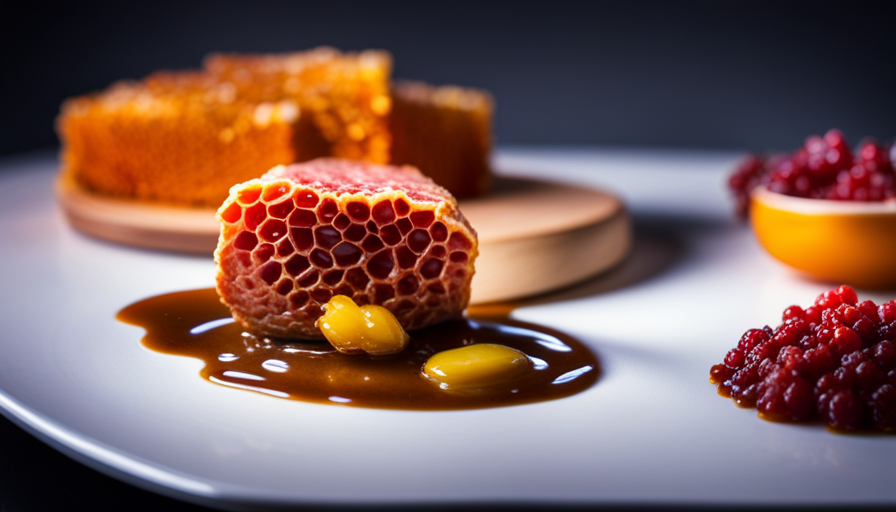Feeling stressed out and confused, just like a mouse trying to find its way through a maze, while trying to feed your precious kitten a raw food diet? Don’t fret any longer, because we have the answers you’ve been searching for!
When it comes to nourishing your furry friend, a raw food diet can provide numerous benefits that will have them purring with delight. But how much should you feed them to ensure they’re getting all the nutrients they need?
In this article, we’ll dive into the scientific evidence and expert advice to help you navigate the world of kitten raw food diets. From understanding their nutritional requirements to selecting the right ingredients, we’ll guide you step by step.
We’ll even cover feeding guidelines, monitoring your kitten’s health, and debunking common misconceptions. So, put on your lab coat and let’s embark on this feline nutrition journey together!
Key Takeaways
- Feeding kittens a raw food diet provides numerous benefits for their overall health and well-being.
- Kittens should be fed small, frequent meals at least four times a day.
- A balanced raw food diet for kittens includes a variety of protein sources, bone, and supplements like taurine.
- Portion sizes should be adjusted based on kittens’ growth and activity levels to maintain a healthy weight.
The Benefits of a Raw Food Diet for Kittens
You’ll be amazed by the numerous benefits your kitten will experience on a raw food diet! Feeding your kitten a raw food diet can provide a wide range of benefits that will support their overall health and well-being.
One of the primary benefits of a raw food diet is that it meets their nutritional requirements more effectively than traditional processed cat food. Raw food contains all the essential nutrients, vitamins, and minerals that kittens need for optimal growth and development.
By feeding your kitten a raw food diet, you’re providing them with a natural and biologically appropriate diet. This can lead to improved digestion and nutrient absorption, as well as increased energy levels and a healthier coat. The raw food diet also promotes dental health, as chewing on raw meat and bones helps to clean their teeth and prevent the buildup of plaque and tartar.
In addition to these physical benefits, a raw food diet can also support your kitten’s immune system. The natural enzymes and probiotics found in raw food help to strengthen their immune system, making them more resistant to common illnesses and infections.
Overall, feeding your kitten a raw food diet ensures that they receive all the necessary nutrients and promotes their overall health and well-being. Your kitten will thrive on this natural and nutritious diet, and you’ll see the benefits in their energy levels, coat condition, and overall vitality.
Nutritional Requirements for Kittens
With their growing bodies and high energy levels, young felines require a nutrient-rich regimen to thrive and flourish. Feeding your kitten a raw food diet can provide the essential nutrients they need for optimal growth and development. However, it’s important to ensure that you’re meeting their specific nutritional requirements.
To ensure your kitten receives all the necessary nutrients, it’s crucial to follow a proper feeding schedule. Here are some key guidelines to consider:
-
Offer small, frequent meals: Kittens have small stomachs and need to eat more frequently than adult cats. Aim to feed them at least four times a day to provide a steady supply of energy.
-
Provide a balanced diet: A kitten’s raw food diet should consist of a variety of protein sources, such as poultry, fish, and organ meats. Including some bone and supplements like taurine will help prevent nutrient deficiencies.
-
Monitor their weight and adjust portions: Kittens should have a healthy weight gain, but not become overweight. Adjust the portion sizes based on their growth and activity level to maintain an ideal body condition.
-
Consult with a veterinarian: It’s always advisable to consult with a veterinarian to ensure your kitten’s diet meets their specific needs and to address any concerns or questions you may have.
By following these guidelines and providing a well-balanced raw food diet, you can help your kitten grow into a healthy and thriving adult cat.
Choosing the Right Ingredients for a Raw Food Diet
When it comes to nourishing your growing feline companion, selecting the perfect blend of high-quality ingredients is key to ensuring their raw food regimen is packed with all the essential nutrients they need to thrive.
When choosing ingredients for a raw food diet for your kitten, it’s important to focus on selecting appropriate proteins and finding suitable supplements.
Proteins are the building blocks of your kitten’s body and are essential for their growth and development. Look for high-quality sources of protein such as lean meats like chicken, turkey, or rabbit. These meats should be fresh and ideally sourced from reputable suppliers to ensure their safety and nutritional value.
In addition to proteins, your kitten’s raw food diet may require the inclusion of suitable supplements. These supplements can help fill any nutritional gaps and provide additional support for your kitten’s overall health. Some common supplements for a raw food diet include omega-3 fatty acids, which promote healthy skin and coat, and probiotics, which support a healthy digestive system.
By carefully selecting appropriate proteins and finding suitable supplements, you can ensure that your kitten’s raw food diet is nutritionally balanced and meets all their dietary needs. Remember to consult with your veterinarian to determine the specific nutritional requirements of your kitten and to ensure that you’re providing them with the best possible diet for their overall health and well-being.
Preparing and Storing Raw Food for Kittens
Get ready to whip up delicious and nutritious meals for your little furball with these simple tips for preparing and storing your homemade kitty cuisine. When it comes to preparing raw food for kittens, it is crucial to ensure that the ingredients are fresh and of high quality. Start by selecting a variety of meats, such as chicken, turkey, or beef, as the primary protein source. Include organ meats like liver or kidney to provide essential vitamins and minerals. Vegetables like carrots or spinach can be added for added nutritional value.
To prevent contamination and ensure food safety, it is important to follow proper handling and storage practices. Always wash your hands and sanitize all utensils and surfaces before and after preparation. Once the meals are prepared, divide them into portion sizes suitable for your kitten’s age and weight. A good rule of thumb is to feed about 2-4% of their body weight per day, divided into two or three meals.
Proper storage is crucial to maintain the freshness and quality of the raw food. Use airtight containers or resealable bags to store individual portions in the freezer. Label each container with the date of preparation to keep track of freshness. Thaw the frozen meals in the refrigerator overnight before serving. Avoid leaving raw food at room temperature for extended periods to prevent bacterial growth.
By following these guidelines for preparing and storing raw food for your kitten, you can ensure that your furry friend receives the best nutrition while minimizing the risk of foodborne illnesses.
Feeding Guidelines for Kittens on a Raw Food Diet
Feeding little furballs on a raw food diet is like nourishing them with a gourmet feast fit for royalty. When it comes to feeding guidelines for kittens on a raw food diet, it’s important to consider both feeding frequency and portion control.
Kittens have small stomachs and high energy needs, so they require frequent meals throughout the day. Aim to feed them three to four times a day, spacing meals evenly to prevent overeating or hunger.
When it comes to portion control, it’s crucial to provide the right amount of food for your kitten’s age and size. A general guideline is to feed about 2-3% of their body weight per day. However, it’s best to consult with your veterinarian for a more accurate recommendation based on your specific kitten’s needs.
Keep in mind that every kitten is unique, and their appetite may vary. It’s essential to monitor their body condition and adjust the portion size accordingly. Overfeeding can lead to obesity, while underfeeding can result in malnutrition. It’s also important to ensure a balanced diet by including a variety of protein sources and adding supplements like omega-3 fatty acids and taurine.
By following these feeding guidelines, you can ensure that your little furball receives the right amount of nutrition and thrives on their raw food diet.
Introducing a Raw Food Diet to Your Kitten
Introducing a raw food diet to your little furball can be an exciting and healthy adventure for both of you. When transitioning your kitten to a raw food diet, it’s important to do so gradually. Start by mixing a small amount of raw food with their current diet, gradually increasing the proportion of raw food over time. This will allow their digestive system to adjust and prevent any potential gastrointestinal upset.
While a raw food diet can offer numerous benefits, it’s important to be aware of potential risks and take necessary precautions. One of the main concerns is the risk of bacterial contamination. Raw meat can carry harmful bacteria such as Salmonella or E. coli, which can pose a risk to both your kitten’s health and yours. To minimize this risk, make sure to handle raw food properly, wash your hands thoroughly after handling it, and clean all utensils and surfaces that come into contact with the raw food.
Additionally, it’s important to ensure that your kitten’s raw food diet is nutritionally balanced. Consult with a veterinarian or a feline nutritionist to ensure that your kitten is receiving all the necessary nutrients in the right proportions. They can guide you on choosing the right raw food products or recommend supplements if needed.
By introducing a raw food diet gradually and taking necessary precautions, you can provide your little furball with a healthy and nutritious diet that can support their overall well-being.
Monitoring Your Kitten’s Health and Progress
Make sure to closely observe your little furball’s health and progress as you transition them to a raw food diet, so you can ensure they’re thriving and adapting well to the new eating plan.
Monitoring your kitten’s weight gain is crucial during this time. You want to make sure they’re gaining weight at a healthy rate. If you notice any sudden weight loss or lack of weight gain, it’s important to consult with your veterinarian to rule out any potential health issues.
In addition to weight gain, keep an eye out for any other changes in your kitten’s overall health. A raw food diet should provide them with all the essential nutrients they need, but it’s still important to monitor their energy levels, coat condition, and overall well-being. If you notice any negative changes, it may be necessary to adjust their diet or seek further veterinary advice.
While a raw food diet can offer numerous benefits for your kitten’s health, there are also potential health risks to consider. Raw meat can contain harmful bacteria such as Salmonella or E. coli, which can pose a risk to both your kitten and yourself. It’s important to handle raw food carefully, following proper hygiene practices to minimize the risk of contamination.
By closely monitoring your kitten’s health and progress, you can ensure they’re thriving on their raw food diet and address any potential issues promptly. Remember to consult with your veterinarian for guidance and support throughout this transition period.
Common Concerns and Misconceptions about Raw Food Diets for Kittens
Did you know that there are some common concerns and misconceptions about feeding a raw food diet to your furry friend? Let’s address these concerns and clear up any misconceptions so you can make an informed decision for your kitten’s health.
-
Raw food diets are dangerous: Contrary to this belief, raw food diets can be safe and beneficial for kittens. Proper handling and preparation techniques, such as freezing the food to kill potential pathogens, can minimize the risk of foodborne illnesses.
-
Nutritional deficiencies: Some people worry that raw food diets may not provide all the necessary nutrients for kittens. However, when properly balanced, raw food diets can meet all their nutritional needs. Consult with your veterinarian or a veterinary nutritionist to ensure your kitten’s diet is complete and balanced.
-
Dental health concerns: Switching to a raw food diet doesn’t automatically guarantee better dental health for your kitten. Regular dental care, such as brushing their teeth and providing appropriate dental toys, is still necessary to maintain good oral hygiene.
While there may be common concerns and misconceptions surrounding raw food diets for kittens, with proper handling, balanced nutrition, and regular dental care, this type of diet can be a healthy option for your furry friend. Always consult with your veterinarian to ensure you’re making the best decision for your kitten’s individual needs.
Transitioning from a Raw Food Diet to Adult Cat Food
Transitioning from a raw food diet to adult cat food can be a gradual process, allowing your feline companion’s digestive system to adjust to the new nutrients and textures. It’s important to remember that kittens have different nutritional needs than adult cats, so a smooth transition is crucial to their overall health and well-being.
The transitioning process should be done over a period of about one to two weeks. Start by mixing a small amount of the new adult cat food with the raw food diet, gradually increasing the ratio of adult cat food to raw food over time. This’ll help your kitten’s digestive system adapt to the new food without causing any stomach upset.
During this transition, you may come across some potential challenges. Your kitten may initially resist the new food, as they’re accustomed to the taste and texture of raw food. To encourage them to eat the adult cat food, try warming it up slightly or adding a small amount of water to enhance the aroma and make it more appealing.
It’s also important to monitor your kitten’s weight and overall health during the transition. If you notice any significant changes or concerns, consult with your veterinarian for guidance.
By following a gradual transitioning process and being mindful of any potential challenges, you can ensure a smooth transition from a raw food diet to adult cat food, providing your kitten with the necessary nutrients for a healthy and happy life.
Consulting with a Veterinarian for a Balanced Diet
When it comes to ensuring a balanced diet for your feline companion, it’s essential to consult with a veterinarian. They have the knowledge and expertise to guide you in providing the right nutrients for your kitten’s growth and development.
A balanced diet is crucial to maintain your kitten’s overall health and prevent any nutritional deficiencies or imbalances.
During a veterinary consultation, your veterinarian will assess your kitten’s specific needs based on factors such as age, breed, size, and any underlying health conditions. They will recommend the appropriate amount of food to feed your kitten to ensure they are receiving the right balance of proteins, carbohydrates, fats, vitamins, and minerals. Weight and body condition will also be taken into consideration to prevent overfeeding or underfeeding.
Additionally, a veterinarian can provide valuable advice on the best type of food for your kitten, whether it be commercial kitten food or a homemade raw diet. They can also address any concerns you may have regarding allergies, dietary intolerances, or special dietary needs.
By consulting with a veterinarian, you can ensure that your kitten’s diet is tailored to their specific requirements, promoting optimal health and well-being. Remember, a balanced diet is the foundation for a healthy and happy feline companion.
Frequently Asked Questions
Can I feed my kitten a raw food diet if they have a sensitive stomach?
Yes, you can feed your kitten a raw food diet even if they have a sensitive stomach. Raw food diets for kittens with sensitive stomachs can be a great alternative option. Raw food is easier to digest and can provide essential nutrients that are beneficial for their overall health. However, it’s important to introduce the raw food gradually and monitor their response. If your kitten still has issues, you can explore other options such as cooked or commercially prepared diets specifically formulated for sensitive kittens.
How can I ensure my kitten is getting all the necessary nutrients on a raw food diet?
To ensure your kitten is getting all necessary nutrients on a raw food diet, it’s important to address common nutrient deficiencies.
Kittens require a balanced intake of proteins, fats, vitamins, and minerals. Common deficiencies on a raw food diet for kittens include calcium, taurine, and vitamin D.
To mitigate these deficiencies, consider adding bone meal or calcium supplements, organ meats, and fish to their diet.
Regular veterinary check-ups can also help monitor their nutrient intake and overall health.
Is it safe to feed my kitten raw meat from the grocery store?
Sure, you can feed your precious kitten raw meat from the grocery store, because who needs regulations and quality control, right? Just make sure you’re choosing reliable raw meat sources.
Now, let’s talk about the benefits of a raw food diet. This type of diet can provide essential nutrients, enzymes, and promote dental health. However, it’s crucial to consult with a veterinarian to ensure your kitten’s nutritional needs are met and to minimize the risk of bacterial contamination.
Can I mix dry kibble with raw food for my kitten’s diet?
Yes, you can mix dry kibble with raw food for your kitten’s diet to ensure nutritional balance. However, it’s important to note that a complete and balanced raw diet can meet all of your kitten’s nutritional needs. Mixing kibble with raw food may reduce the potential benefits of a raw diet.
Kibble is processed and cooked, which can alter its nutrient content. It’s best to consult with your veterinarian to determine the most appropriate diet for your kitten.
How often should I feed my kitten on a raw food diet?
Transitioning your kitten to a raw food diet requires a gradual approach, like guiding them through a labyrinth to a hidden treasure. Begin by mixing a small amount of raw food with their current diet, gradually increasing the ratio over a few weeks. The benefits of a raw food diet for kittens include improved digestion, healthier skin and coat, and increased energy levels.
Feed your kitten on a raw food diet three to four times a day, adjusting portion sizes based on their age and weight.
How Can I Safely Implement a Raw Food Diet for My Kitten?
When implementing a raw food diet for your kitten, it’s important to understand the raw food meaning. Ensure the food is properly sourced, balanced, and nutritionally complete. Consult with a veterinarian to create a safe and appropriate plan for transitioning your kitten to a raw food diet.
Conclusion
In conclusion, feeding your kitten a raw food diet can have numerous benefits for their overall health and well-being. By meeting their nutritional requirements with carefully chosen ingredients and properly preparing and storing the food, you can ensure your kitten receives all the necessary nutrients.
It is important to monitor their health and progress closely and address any concerns or misconceptions about raw food diets. As your kitten grows, you may need to transition them to adult cat food, but consulting with a veterinarian will help ensure a balanced diet.
Remember, the key is providing your kitten with a wholesome and balanced diet for a long and happy life.










